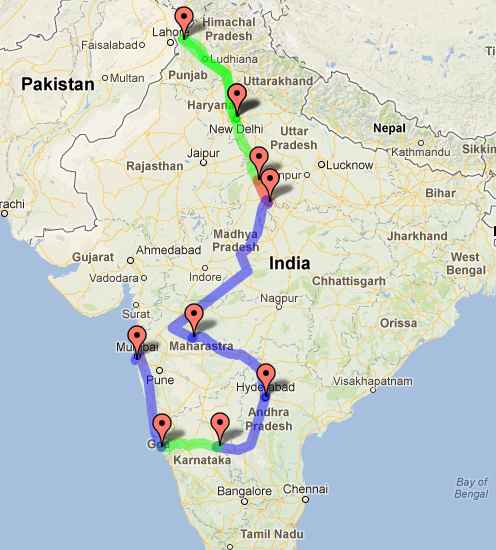In late July 2011, exactly 7 months after Amy was diagnosed with type 1 diabetes, we backpacked around India for four weeks, in a trip we called Monsoon Meandering.
This is post 3 in the series about that trip and its planning and how type 1 diabetes played a part. This post doesn’t actually contain any information about diabetes but if you’re thinking of going to India then getting your visa is an important part.
Caveat: visa rules change quite frequently and what’s below is what happened for us in 2011.
Do I really nead a visa?
Yes, unless you’re from a country neighbouring India you’re probably going to need to organise your visa way in advance. Only certain countries’ residents can get a visa-on-arrival when landing in India.
Don’t peak too soon
The first thing about a visa for India is that it starts the moment it is processed and first timers are likely to just get a 3 month or 6 month visa.
If you’re going on holiday to India in August you might think applying for your visa in April is a good idea, just in case there’s a backlog or problems with your application. If they grant you a 3 month visa it’ll run out before your flight leaves. Even if they grant you a 6 month visa it’ll run out in October which isn’t great if you’re planning a four month stay. So timing is of the essence and the best thing you can do is find out about the current situation by joining the free forum IndiaMike.com, get yourself to the Visa section and in particular this thread.
I found it incredibly naive that the visa centre suggest that you don’t even book your flight until you’ve got your visa, yet the visa starts immediately it’s issued. Due to flight pricing getting higher the nearer the departure it means that virtually everyone will book their flights way before.
Getting photos for the visas
The photos we needed were not the normal size passport photos we’re used to – 45mm x 35mm – but instead were 50mm x 50mm. Local shops will take your photo for you but the cheapest I found at the time were £15 per person. This would have added £60 to the cost of the visas (£50 each) so I dug out my camera, took the photos, edited them using free software from the internet and saved myself probably £59 in the process.
If you go to the visa centre in person before you even get to the waiting room a clerk will check your photos are the correct size. If they’re not you’ll be sent to the nearest (probably expensive) photo booth.
Our application process
We filled in our applications electronically, printed them off and booked an appointment for the following week at the offices in Victoria. Amy’s school had a day off and we used it to have an enjoyable trip to London and sort the visas out too.
I was slightly nervous at the visa office: what if my photos were rubbish, they weren’t; what if I’d filled in all the application forms wrong, I hadn’t; what if; what if; what if.
As always I’d done my homework, stuck to the rules and our applications were fine.
It’s worth noting that normally you won’t get your visa on the day you apply as it is sent from the visa centre to High Commission of India to be rubber-stamped, presuming it’s a straight forward application. Visas are normally sent back by post or can be collected and ours were received in the post within a week, far quicker than I’d expected.
Parents taking their kids need an authorisation letter, from themselves
In yet another ‘only in India’ scenario any parent wanting to get a visa for their kid have to have an authorisation letter for each child, signed by each parent. It sounds odd but it’s in the rules so we did it, thinking all the time that we’d misunderstood them. We hadn’t, we needed those letters.
Whilst in my appointment I overheard an argument between a parent (of Indian origin) and the official. He maintained that as he was of Indian origin the rule didn’t apply to him – it did – and that he would just write a letter now, but he couldn’t as he’d made the trip to London without his wife so she couldn’t sign it. Because he didn’t read/believe the rules his trip to London was wasted.
I managed to contain my smirk at having read the rules properly.
Next up: buying travel insurance



